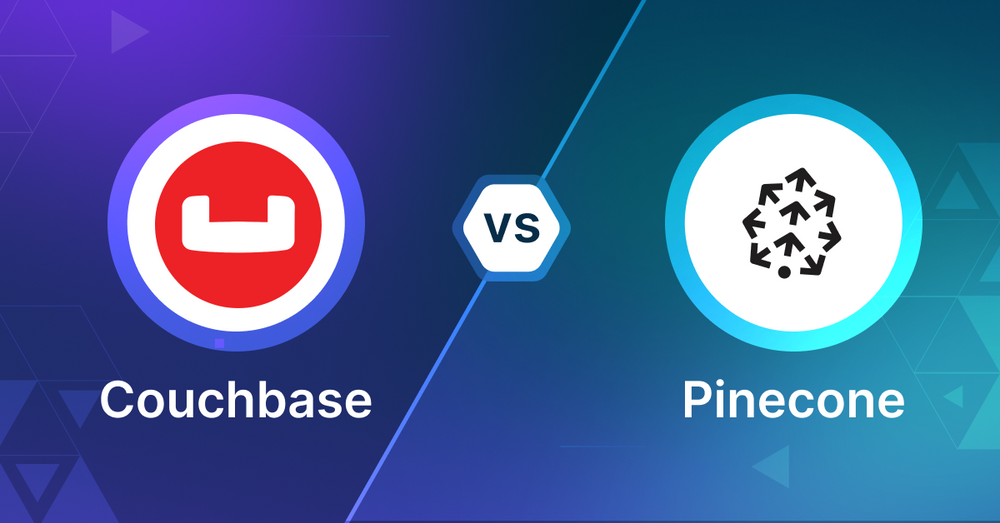Couchbase vs Pinecone Choosing the Right Vector Database for Your AI Apps

What is a Vector Database?
Before we compare Couchbase and Pinecone, let's first explore the concept of vector databases.
A vector database is specifically designed to store and query high-dimensional vectors, which are numerical representations of unstructured data. These vectors encode complex information, such as the semantic meaning of text, the visual features of images, or product attributes. By enabling efficient similarity searches, vector databases play a pivotal role in AI applications, allowing for more advanced data analysis and retrieval.
Common use cases for vector databases include e-commerce product recommendations, content discovery platforms, anomaly detection in cybersecurity, medical image analysis, and natural language processing (NLP) tasks. They also play a crucial role in Retrieval Augmented Generation (RAG), a technique that enhances the performance of large language models (LLMs) by providing external knowledge to reduce issues like AI hallucinations.
There are many types of vector databases available in the market, including:
- Purpose-built vector databases such as Milvus, Zilliz Cloud (fully managed Milvus)
- Vector search libraries such as Faiss and Annoy.
- Lightweight vector databases such as Chroma and Milvus Lite.
- Traditional databases with vector search add-ons capable of performing small-scale vector searches.
Couchbase is a distributed multi-model NoSQL document-oriented database with vector search as an add-on and Pinecone is a purpose-built vector database. This post compares their vector search capabilities.
Couchbase: Overview and Core Technology
Couchbase is a distributed, open-source, NoSQL database that can be used to build applications for cloud, mobile, AI, and edge computing. It combines the strengths of relational databases with the versatility of JSON. Couchbase also provides the flexibility to implement vector search despite not having native support for vector indexes. Developers can store vector embeddings—numerical representations generated by machine learning models—within Couchbase documents as part of their JSON structure. These vectors can be used in similarity search use cases, such as recommendation systems or retrieval-augmented generation both based on semantic search, where finding data points close to each other in a high-dimensional space is important.
One approach to enabling vector search in Couchbase is by leveraging Full Text Search (FTS). While FTS is typically designed for text-based search, it can be adapted to handle vector searches by converting vector data into searchable fields. For instance, vectors can be tokenized into text-like data, allowing FTS to index and search based on those tokens. This can facilitate approximate vector search, providing a way to query documents with vectors that are close in similarity.
Alternatively, developers can store the raw vector embeddings in Couchbase and perform the vector similarity calculations at the application level. This involves retrieving documents and computing metrics such as cosine similarity or Euclidean distance between vectors to identify the closest matches. This method allows Couchbase to serve as a storage solution for vectors while the application handles the mathematical comparison logic.
For more advanced use cases, some developers integrate Couchbase with specialized libraries or algorithms (like FAISS or HNSW) that enable efficient vector search. These integrations allow Couchbase to manage the document store while the external libraries perform the actual vector comparisons. In this way, Couchbase can still be part of a solution that supports vector search.
By using these approaches, Couchbase can be adapted to handle vector search functionality, making it a flexible option for various AI and machine learning tasks that rely on similarity searches.
Pinecone: Overview and Core Technology
Pinecone is a SaaS built for vector search in machine learning applications. As a managed service, Pinecone handles the infrastructure so you can focus on building applications not databases. It's a scalable platform for storing and querying large amounts of vector embeddings for tasks like semantic search and recommendation systems.
Core Features
Key features of Pinecone include real-time updates, machine learning model compatibility and a proprietary indexing technique that makes vector search fast even with billions of vectors. Namespaces allow you to divide records within an index for faster queries and multitenancy, ensuring only relevant records are scanned during data operations. Pinecone also supports metadata filtering, so you can add context to each record and filter search results for speed and relevance.
Data Management and Processing
Pinecone's serverless offering makes database management easy and includes efficient data ingestion methods. One of the features is the ability to import data from object storage, which is very cost effective for large scale data ingestion. This uses an asynchronous long running operation to import and index data stored as Parquet files. For pod-based indexes or when bulk import isn't suitable, you can use batch upsert to load up to 1,000 records at a time.
Search Enhancement Features
To improve search quality, Pinecone hosts the multilanguage-e5-large model for vector generation and has a two-stage retrieval process with reranking using the bge-reranker-v2-m3 model. The reranking process helps ensure more accurate search results by scoring them based on semantic relevance. Pinecone also supports hybrid search which combines dense and sparse vector embeddings to balance semantic understanding with keyword matching.
Platform Benefits
With integration into popular machine learning frameworks, multiple language support and auto scaling, Pinecone is a complete solution for vector search in AI applications with both performance and ease of use. Its combination of proprietary technology, managed infrastructure, and built-in optimization features makes it suitable for both development teams and production environments.
Key Differences
When you’re implementing vector search in your app, you’ll likely consider Couchbase and Pinecone as options. They take different approaches to vector search and understanding these differences will help you choose the right one for your project.
Native vs Adaptation
Pinecone is built for vector search and has native support through its proprietary indexing technique that can handle billions of vectors. Couchbase adapts its existing NoSQL infrastructure for vector search. Couchbase doesn’t have native vector indexing but has several ways to do vector search, Full Text Search adaptation and application level processing.
Search
Pinecone’s vector search is simple - you store your vectors and the system does the rest. It has built-in models like multilanguage-e5-large for embedding generation and bge-reranker-v2-m3 for result optimization. It also supports hybrid search, combining dense and sparse vector embeddings for balanced semantic and keyword matching.
Couchbase requires more manual setup for vector search. You can either adapt the Full Text Search feature by converting vectors into searchable fields or do vector similarity calculations at the application level. For advanced use cases you’ll need to integrate external libraries like FAISS or HNSW to do vector comparisons.
Data Management
Couchbase is versatile, it has relational database features with JSON flexibility. It can handle different data types and structures in the same system, so it’s suitable for applications that need traditional database features and vector search.
Pinecone is focused on vector data management. Its namespace feature divides records for faster queries and supports metadata filtering for more precise searches. It has efficient data ingestion through object storage import or batch upserts, up to 1,000 records per batch.
Scalability and Infrastructure
Pinecone manages the infrastructure for you through its SaaS model, with auto-scaling and serverless options. This reduces operational overhead but binds you to their platform.
Couchbase gives you more control over your infrastructure as an open-source, distributed database. This means you have to manage your own scaling and optimization.
Integration and Ecosystem
Both have integration with popular machine learning frameworks. Pinecone has a more streamlined experience for vector search specific use cases, Couchbase has a broader ecosystem for database operations beyond vector search.
When to Choose Couchbase
Choose Couchbase when you need a database that can do both traditional data ops and vector search. It’s great for applications that need distributed data management, JSON flexibility and vector search alongside regular database ops. Choose Couchbase when you have an existing NoSQL infrastructure, need full control over your deployment or want to use custom vector search with external libraries like FAISS or HNSW. It’s good for teams that have the technical expertise to manage their own infrastructure and vector search optimisations.
When to Choose Pinecone
Pinecone is the best choice when vector search is your top priority and you need a managed service that takes care of the complexity of vector ops. It’s great for AI applications focused on semantic search, recommendation systems or any use case that requires searching across billions of vectors. The proprietary indexing technique, built-in embedding models and reranking capabilities make it perfect for teams that want to focus on building applications rather than managing vector search infrastructure. Choose Pinecone when you need instant access to optimized vector search without the overhead of implementing and maintaining custom solutions.
Conclusion
The choice between Couchbase and Pinecone comes down to your vector search requirements. Couchbase offers flexibility and control in a broader database context so is good for applications that need traditional database features and vector search. Pinecone is a specialized, managed solution for vector ops, so it is great for focused AI and machine learning applications. Your decision should consider your team’s technical expertise, infrastructure preferences, scaling needs and whether vector search is primary or secondary in your application architecture.
Read this to get an overview of Couchbase and Pinecone but to evaluate these you need to evaluate based on your use case. One tool that can help with that is VectorDBBench, an open-source benchmarking tool for vector database comparison. In the end, thorough benchmarking with your own datasets and query patterns will be key to making a decision between these two powerful but different approaches to vector search in distributed database systems.
Using Open-source VectorDBBench to Evaluate and Compare Vector Databases on Your Own
VectorDBBench is an open-source benchmarking tool for users who need high-performance data storage and retrieval systems, especially vector databases. This tool allows users to test and compare different vector database systems like Milvus and Zilliz Cloud (the managed Milvus) using their own datasets and find the one that fits their use cases. With VectorDBBench, users can make decisions based on actual vector database performance rather than marketing claims or hearsay.
VectorDBBench is written in Python and licensed under the MIT open-source license, meaning anyone can freely use, modify, and distribute it. The tool is actively maintained by a community of developers committed to improving its features and performance.
Download VectorDBBench from its GitHub repository to reproduce our benchmark results or obtain performance results on your own datasets.
Take a quick look at the performance of mainstream vector databases on the VectorDBBench Leaderboard.
Read the following blogs to learn more about vector database evaluation.
Further Resources about VectorDB, GenAI, and ML
- What is a Vector Database?
- Couchbase: Overview and Core Technology
- Pinecone: Overview and Core Technology
- Core Features
- Data Management and Processing
- Search Enhancement Features
- Platform Benefits
- Key Differences
- Native vs Adaptation
- Search
- Data Management
- Scalability and Infrastructure
- Integration and Ecosystem
- When to Choose Couchbase
- When to Choose Pinecone
- Conclusion
- Using Open-source VectorDBBench to Evaluate and Compare Vector Databases on Your Own
- Further Resources about VectorDB, GenAI, and ML
Content
Start Free, Scale Easily
Try the fully-managed vector database built for your GenAI applications.
Try Zilliz Cloud for FreeKeep Reading

Our Journey to 35K+ GitHub Stars: The Real Story of Building Milvus from Scratch
Join us in celebrating Milvus, the vector database that hit 35.5K stars on GitHub. Discover our story and how we’re making AI solutions easier for developers.

1 Table = 1000 Words? Foundation Models for Tabular Data
TableGPT2 automates tabular data insights, overcoming schema variability, while Milvus accelerates vector search for efficient, scalable decision-making.

Empowering Women in AI: RAG Hackathon at Stanford
Empower and celebrate women in AI at the Women in AI RAG Hackathon at Stanford. Engage with experts, build innovative AI projects, and compete for prizes.
The Definitive Guide to Choosing a Vector Database
Overwhelmed by all the options? Learn key features to look for & how to evaluate with your own data. Choose with confidence.